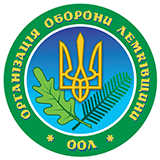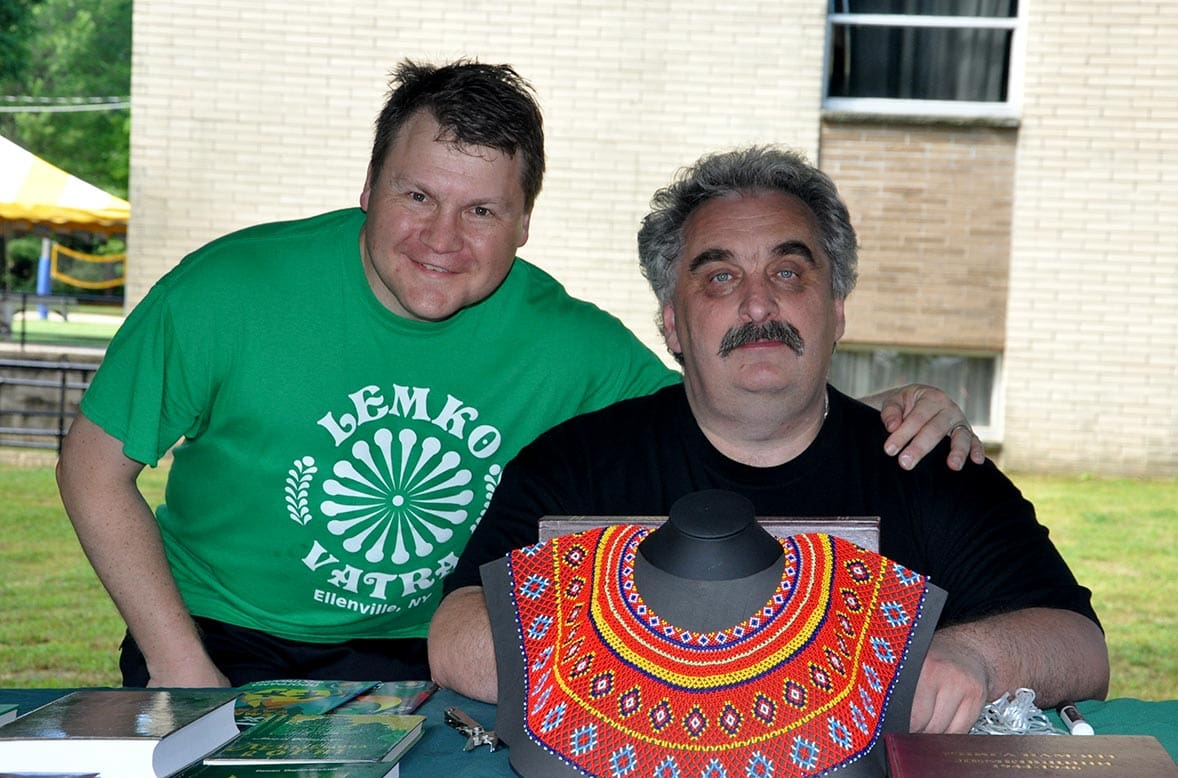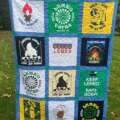
Our mountains, our mountains,
our mountains the Carpathians,
I would not change you,
Not for any amount of money.
(From Lemko hymn)
I was lucky enough to recently be in theCatskill Mountains, in the northern part of New York state, not far from the village of Ellenville, where the camp resort of the Ukrainian American Youth Association is located. Forests, mountains, sweet air remind us of our Carpathians. Here was the 17th Lemko-Vatra Festival. Everything that I saw, heard and learned, meeting with wonderful Lemkos, became for me another “discovery of America” The stories that I heard stayed with me, provoking frequent visits to Google … As always, I am sharing this discovery with you, dear readers of “Chas and Podija” I think, you also will be interested in the Vatra festival, and the phenomenon of Lemkos survival, etc.
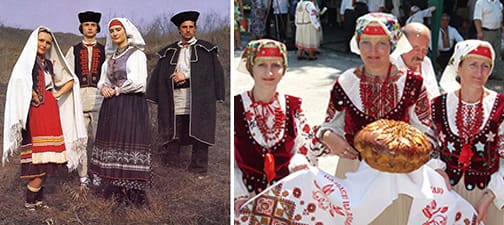
17th Lemko Vatra in United States
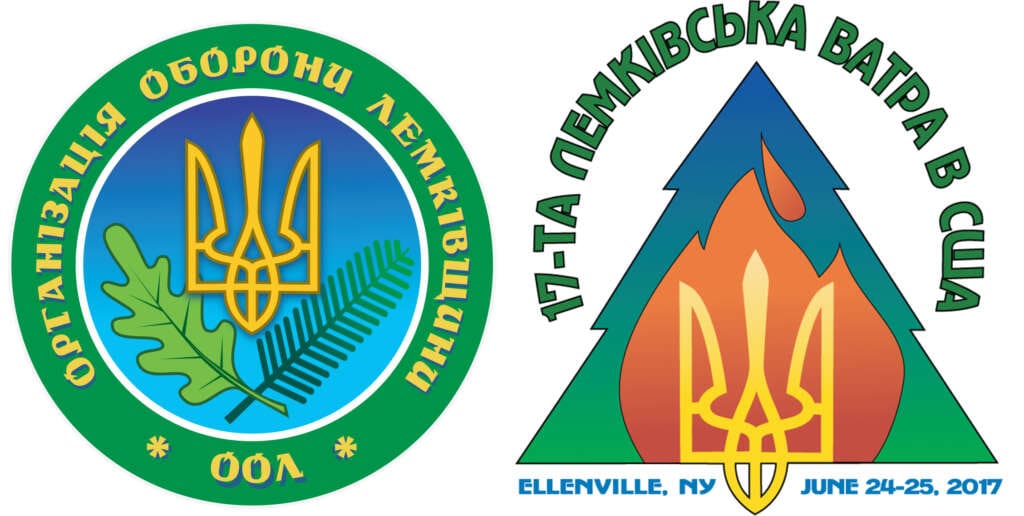
Lemko festivals have been held at CYM’s resort annually since their foundation in 2001. They are organized by the Organization for the Defense of Lemkivshchyna in America (OOL). In this 2017, the festival took place on June 24-25. Immediately I should say that it differs from the usual cultural festivals of our communities in format and spirit.
I regret that I visited it for the first time because I denied myself knowledge and emotions, and a feeling of that very special spirit. The festival is not massive, it is more like family. It has its own tradition. The opening of the festival in this green, cozy CYM resort starts with lighting of the vatra. It is the symbol of warmth, hot hearts and eternally invincible spirit. Lemkos are friendly, ambitious, patriotic, hardworking and great enthusiasts. United by common goals and friendship, they are also members of formal local organizations: they pay membership fees, hold frequent meetings in their unions, congresses in the States and congresses of the World Federation of Ukrainian Lemko Unions. They even have created quite a large online communities of the Lemko descendants in the United States, offering them the option to fill out an online application form and pay a membership fee. They have their press – the magazine “Lemkivshchyna”. They have their Lemko Museum (Stamford, Connecticut).
For the most part, the organizers of “Vatras” and their annual guests know each other. And they are very friendly, hospitably welcoming new visitors to their group. While visiting Vatra-17, I made many new friends. I’ll name a few, because, I think, people are interested in knowing the everyday heroes of their social lives. I was met by Halyna Semenyak – director and host of the concert programs: energetic, business-like, mobile, and knows everyone and everything. Together with her husband Volodymyr, they have been involved in the preparation and running of festivals for 11 years. Vasyl Harhai is the constant “starosta” of all “Vatras” for 17 years since its founding in 2001: forever young, because strength and persistence are needed constantly. His greatest achievement was the implementation of the idea to build a chapel in memory of the criminal Operation Vistula at the CYM’s resort using funds collected by OOL. Now church services are conducted there. And since 2012, Mr. Vasil has headed the OOL branch in Passaic (New Jersey).
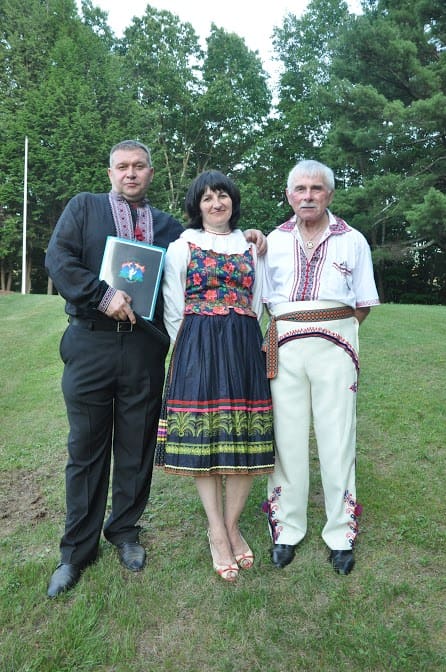
Andriy Khomyk is the President of the “Lemko Research Foundation”. He is a “walking encyclopedia” on any issue of history and culture of Lemkivshchyna and an active, skillful, wise popularizer of knowledge about it through print, the Internet, and his oral word. The Foundation is a scientific association that accumulates funds for publishing books and magazines on the Lemko theme. For two days, Mr Khomyk sold these books to the guests, skilfully promoting them. In a small interview, he managed to tell me in general but exciting the multi-volume long-suffering history of Lemkos.
Mark Howansky is unique! Born in the States, therefore per official status – he is an American, but in spirit and heart – he is a Ukrainian Lemko. Already in his second term, he directs the National Board of OOL with zealousness and enthusiasm, he helps his countrymen with social work, and together with CYM’s administration organized a whole program of studying Lemkivshchyna’s history for all CYM’s members; and in his plans is the dissemination of this knowledge in Plast and Ukrainian Saturday schools. He engages in translation of Lemko books into English. He attracts people and forms the virtual community of America’s Lemkos through social media (Internet). He studies and listens to the experience of the older generation of Lemkos activists, working with them hand in hand (a good example for our communities). He is worthy son of his father – a well-known figure of the Lemkos of blessed memory of Stefan Howansky who, during 40 (!!!) years, headed one of the most effective branches in Yonkers (New York), сreated the Lemko Museum, which is still active. Andriy Khomyk, remembering his sworn brother, whom he replaced as the head of the Foundation, said that Mr. Stefan had educated his children – a son and two daughters – as dedicated patriotic Ukrainians, taught them language, and love for the culture of their people. They have become public figures. And Marko, as the head of OOL, as the leader of the American Lemkos, also is valuable for the community because he utilized the tools of modern management and marketing. By the way, Marko and Andriy together operate the joint website of the “Organization of the Defense of Lemkivshchyna” and “Lemko Research Foundation” (www.lemko-ool.com).
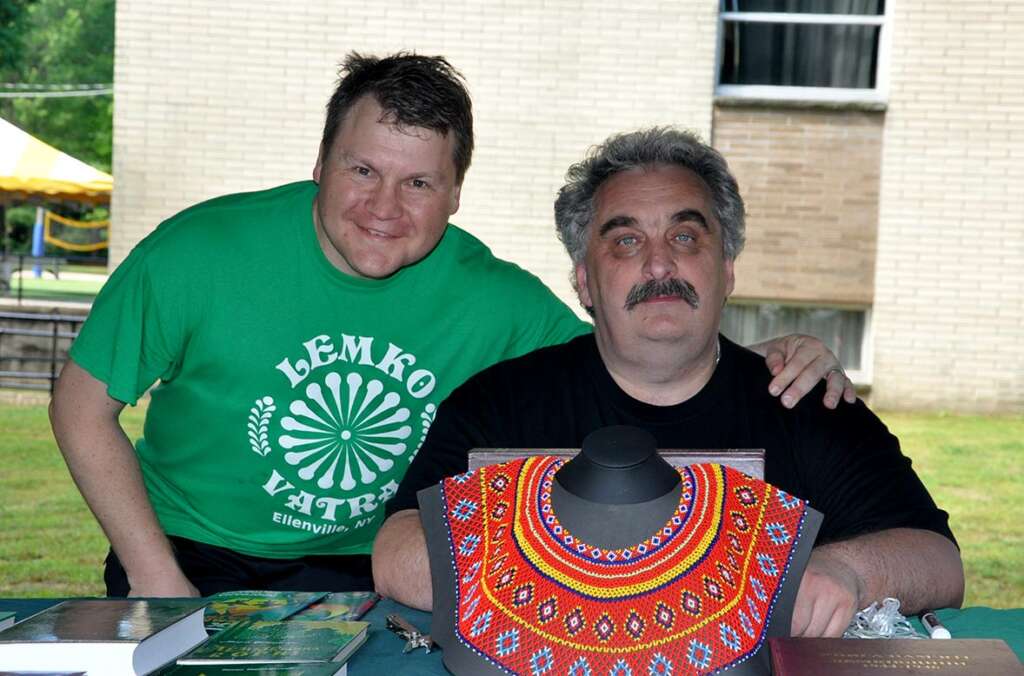
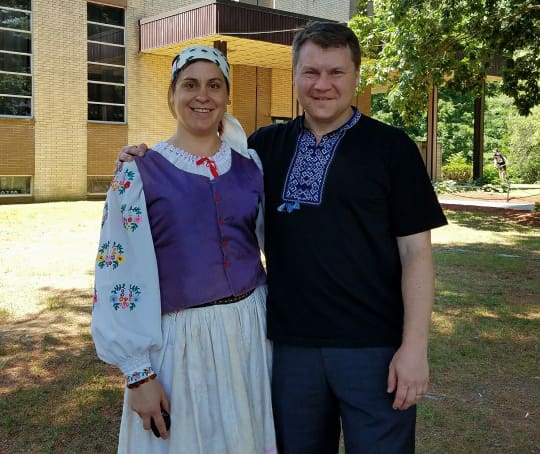
together with his sister Lena Howansky who is a director of the Lemko Museum in Stamford, a member of the 2nd Division of the OOL (Yonkers)
Petro Kosciolek, a former manager of CYM, today he is an active member of the OOL’s National Board, very open to communication and assistance. Friendly Mykhaylo Chomyk has been managing for one of the most active OOL centers in New York for many years, and also sings in the band “Na Lemkowyni”.
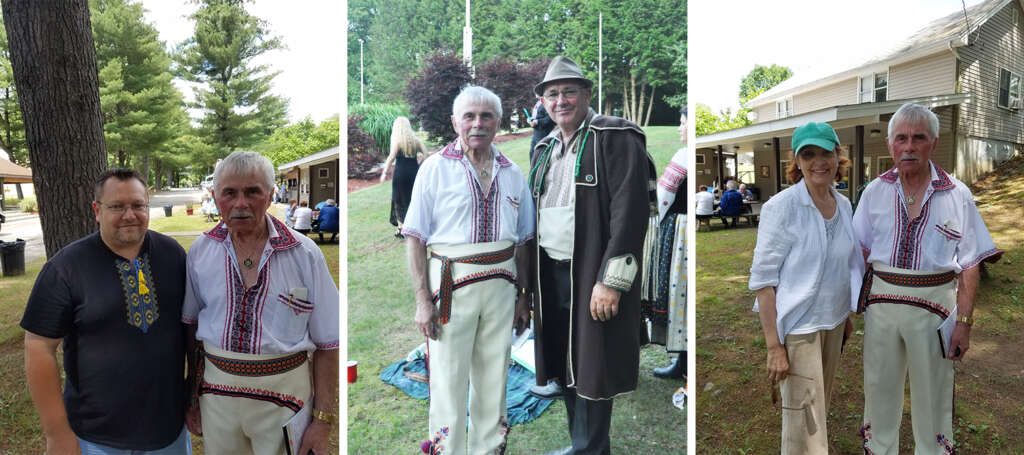
-Peter Kosciolek is member of the OOL National Board,
-Mykhaylo Chomyk is the head of the 1st branch of OOL (New York City),
-and Lydia Korsun is the author.
Married couple Mary and Stefan Pzybylo from Jersey-City – for over 20 years – they are one of the most active people in the OOL of New York. So much love to their native abandoned land – Lemkivshchyna – I heard in their story!
However, now I will pause. Our new story about “The hardworking and friendly Lemkos of the United States”, can be continued by naming more and more people… So we will continue later. And meantime, we would like to emphasize that every Lemko in our American diaspora deserves such or similar words. If we remember all those who constantly provide financial contributions and humanitarian aid to the needy Lemkos, scattered by fate around the world, who now deprive themselves, helps the ATO fighters and the wounded … Who contrary to the forces of assimilation preserve culture, customs of their people, preserve memories of their roots, which, as you know, best nourishes the patriotism of each of us.
And now, what happened at the festival.
Cinema and concert “Vatra-17”
The Saturday program began with a four-hour film show of thematic documentaries and feature films of Lemko themes. The best way to get the guests to know your history. And this program was conducted by Andriy Khomyk, who is already familiar to us. (Meanwhile, a whole marinate pig was traditionally roasted on the grill – also a feature of the Ukrainian-Lemko cuisine at the Lemko festivals. You’ll taste it if come here next year).
For two days, the “bookstore” of the Lemko Research Fondation issues was open.
And what is a festival without a concert? Everyone was waiting for it. The bright, elite printed brochure “Program of the Festival” (design by Andriy Khomyk) intrigues with bright photos, surnames and groups of the concert participants.
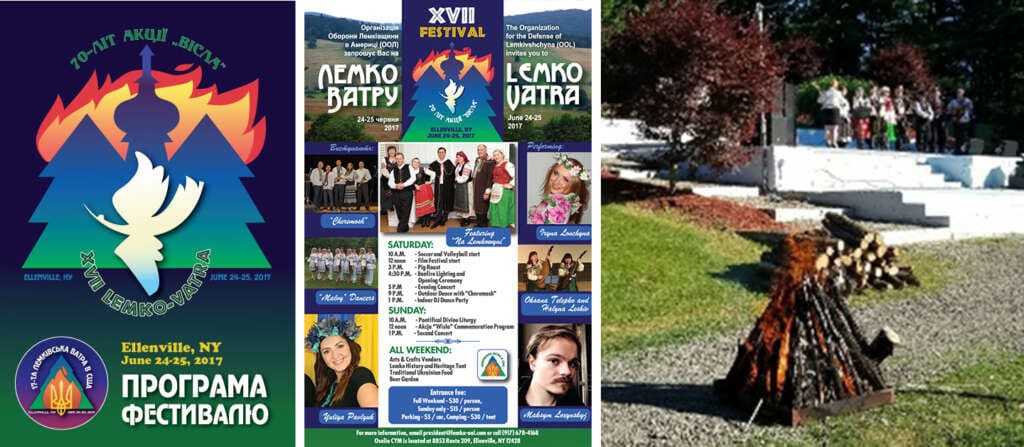
On Saturday, just after the Vatra (“fire”) was lit, in the open-air stage, the hymn of the Lemkos (in Lemko, of course, the dialect) was performed: ): (Our mountains, our mountains, // our mountains the Carpathians, // no one knows, no one would not know // How much you are worth to us. // Our mountains, our mountains, // Our mountains the Beskydy, // They told us not to lose you / Our grandfathers, our great-grandfathers. // Our mountains, our mountains, // Our mountains our Carpathians, // I would not change you // Not for any amount of money //.
Such are the Lemkos: forever in love with their Beskydy: they will not change their Carpathians for any money (ducaty).
The festival is open. The difference of this year’s festival from the previous ones was that here for the first time made performance a newly formed the first vocal folklore group “Na Lemkowyni”, consisted of 7 singers – ethnic Lemkos born in Lemkivshchyna.
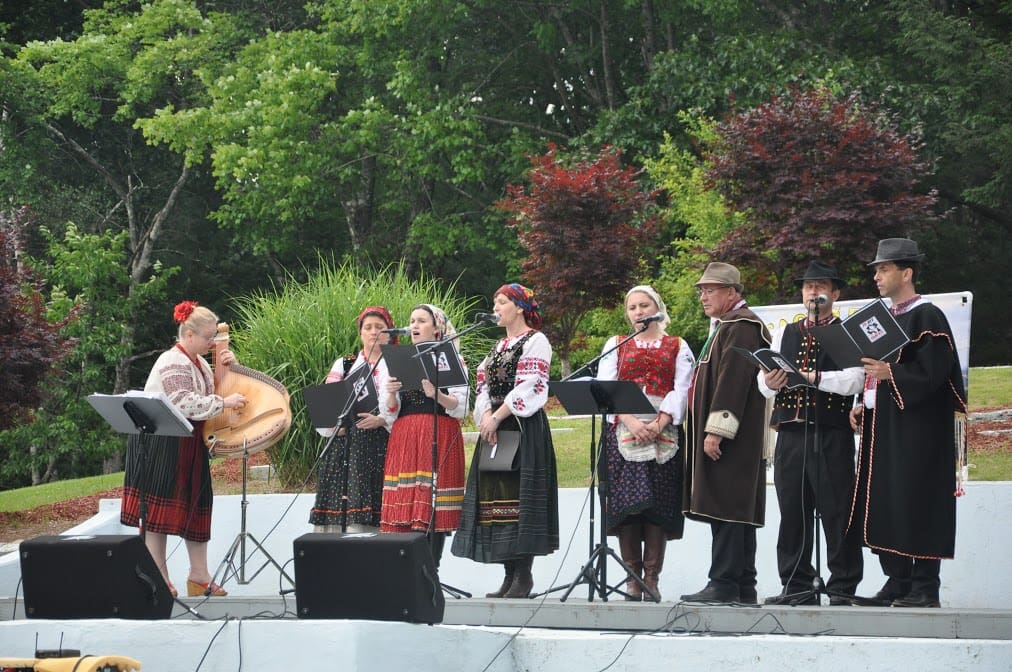
For them, the Lemko dialect is not only native, but also alive, and people have heard the authentic sounds of the Lemko language. And when they sang “Our Mountains” (“Hori Nashi”), even when you do not understand all the words – bring tears in eyes. Lemkos are mountainous people, they lived for ages on the stony lands of the Carpathians, which were stretched out in the territories of Western Ukraine, Poland, Slovakia. Therefore, the dearest places for them are the mountains, their Beskids.
Two days guests enjoyed by the music of the ensemble “Cheremosh”.
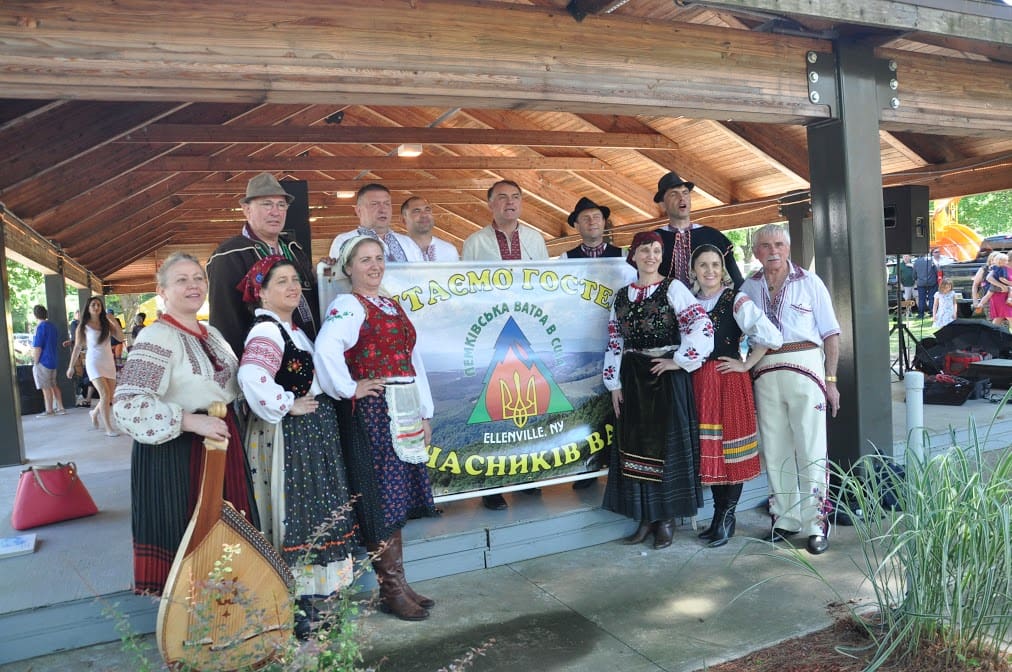
As always, guests warmly welcomed during two days the well-known honored artist of Ukraine Iryna Lonchyna, who, in addition to her author’s songs “The Wreath of My Songs” (“Vinok mojih pisen”), “This Is My Ukraine” (Ce moja Ukrajina), “Ukrainian Land” (“Ukrajinska zemlja”), “My sister” (“Moja sestra”), performed a warm, well-known Lemko songs “Oh, poem, My poem” (“O virshe mij virshe”) and “Under the Cloud” (“Pid Oblachkom”) (listen it on the festival scene here:
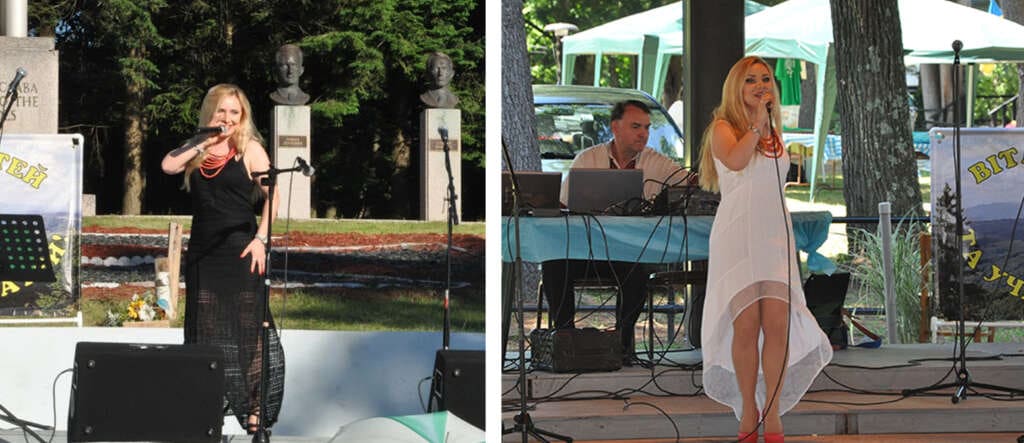
As well as – vocalists Julia Buszko, Julia Pavlyuk, bandura players Alla Kutsevich, Oksana Teleplko and Galina Leskiv, humorist Petro Wyslotsky (pictured below)
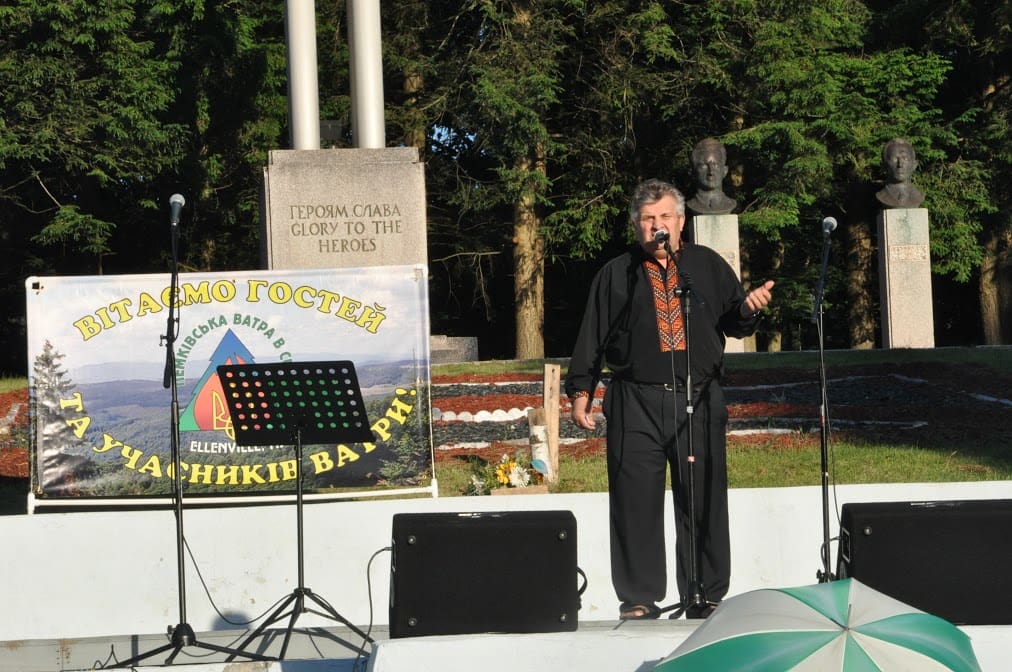
Exciting Ukrainian dances were performed by dance groups “Malvi” (Jersey City) and “Obrij” (Passaic).

70th anniversary of the Operation Vistula at “Vatra-17”

This year the Lemko community of world commemorates the sad date: 70 years ago, that is, in 1947, the regime of Poland with the blessing of Moscow, forcefully displaced almost 150,000 Lemkos (and Boykos) from their fatherland (Lemkivshchyna) and scattered them on the lands that became Poland by the results of borders redistribution after the Second World War (present territory in the area of city Wroclaw). The operation is conventionally called “Vistula”. In fact, it was ethnic cleansing of Ukrainians, a huge human tragedy; many people were killed, disobedient were placed in a concentration camp. Moreover, in 1944-1951, a Soviet-Polish exchange of population took place, as a result of which 490,000 Ukrainians were relocated from Poland to the USSR, in the steppe regions and even in the Donetsk region, and 790,000 Poles were moved in the opposite direction. But Lemkas withstood, retained their identity and organized community.
Therefore, one of the slogans of “Vatra-17” was the slogan and the logo “70 years of the Operation Vistula”. On Sunday, June 25, at the chapel, Reverend Bishop of Stamford UCC, Paul Chomnycky, served the Liturgy and a dirge service.
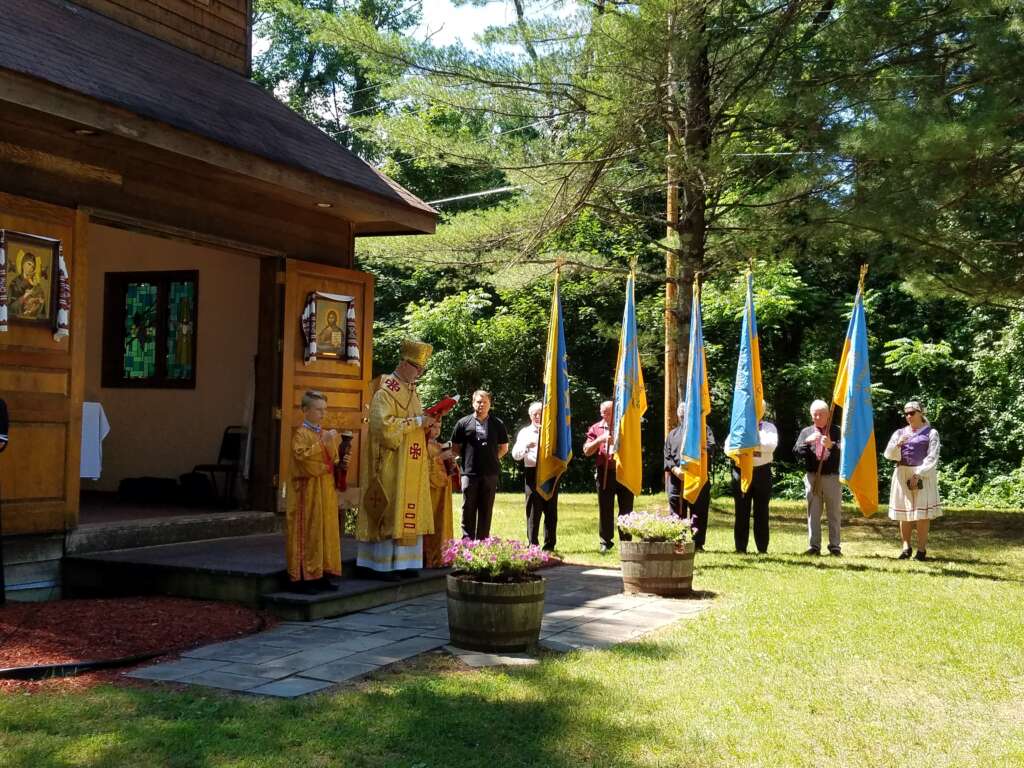
Before the concert, head of the festival Vasyl Harhai made a speech about the event. And the folk Lemko group “Na Lemkovynia” devoted a whole performance set to this topic.
Recall that the head of the OOL Mark Howansky is very proud that he managed to organize educational work with the CYM’s people during the school year 2016-2017, in particular, to conduct a series of lectures devoted to this tragedy, and to involve the CYM to the interview with witnesses of events connected with Operation Vistula. It should be added that all these questions will be raised at the Congress of the World Federation of Ukrainian Lemko Unions in August 2017, in Lviv.
Interview with Andriy Khomyk – Head of the Lemko Research Foundation
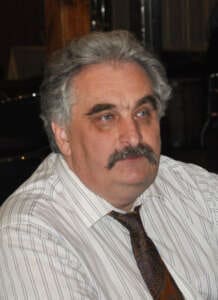
– Mr. Andriy, tell a few words about the World Federation of Lemkos.
– In 1973, the World Federation of Lemkos (SFL) was created, which initially united our organizations in the United States and Canada In 1997, it was renamed the World Federation of Ukrainian Lemko Unions (SFULO). And now it unites Lemko organizations of seven countries. These are the organizations of indigenous Lemkos-Ukrainians of Poland, Ukraine, Slovakia, as well as those who came from Lemkivshchyna to the USA, Canada, Serbia and Croatia.
Our World Federation is headed now by Sophia Fedyna – a well-known public figure, associate professor of Ivan Franko Lviv National University, TV presenter, singer and volunteer.
On August 24-25 we will meet in Lviv for the VI SFULO Congress, which meets once every five years.
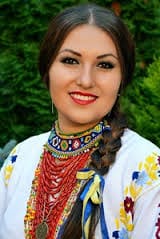
– Judging by the numerous statements made by Ms. Fedyna, posted on the Internet, under the leadership of such a young, charismatic, creative leader and professional expert on the problems of Lemko Region and the history of Ukraine as a whole, you can achieve the goal, in particular, the recognition of the Lemko forced emigration in 1944-51 as a crime against humanity and Operation Vistula in 1947.
– … and as a result, the cultural and ethnic territory of Lemkos has almost ceased to exist. At least, this territory remains 50 times smaller than it was in the early twentieth century. The Lemkos inherited the fate of their parents who never had their own state but stubbornly preserved their language, traditions, and customs and were scattered on the lands of Poland, Slovakia and Western Ukraine.
True, in former times, the territory of Lemkivshchyna was part of the Galician principality, and later became part of Poland, and even later – of Austria-Hungary. And now the Ukrainian Lemkos populate Poland, Slovakia and Ukraine. As a result of Operation Vistula they are scattered, for the most part, in all areas of Galicia, and, in fact, throughout Ukraine.
– And can you tell how deportation was happening, albeit on the testimony of relatives? Your countrymen and my new festival acquaintances said that all their parents were still children between the ages of 2 and 10 when Lemkos were forcibly deported to the then Soviet Ukraine..
– Yes, my father was then 10 years old, but the family was lucky to get to Lviv. So, and I was born in Lviv. Who was fortunate, found themselves in the Ternopil, Lviv, Ivano-Frankivsk regions – all the same closer to his native Carpathians, to his Lemkivshchyna. And tens, hundreds of thousands in 1944-46, in cattle wagons in inhumane conditions were sent to the steppes of more than 10 regions of central and eastern Ukraine: Poltava, Kirovograd, Kyiv, Donetsk, Lugansk, Kherson, Zaporozhye, Kharkiv and others. By this time, their descendants live there, and even now, because of the war; we send humanitarian aid to our people in the Lugansk region.
But many of them, who grew up in the mountains and were genetically adapted to them, could not live in the steppes, and felt themselves there as in the desert. And as they could – legally, illegally, by train, by foot, by horses – began to flee to the west, to Lemkivshchyna. But the borders were already closed, and they remained among the Galician, closer to their lands. Yet here was the Ukrainian language, our Greek-Catholic church. That is why there are about 200 thousand Lemkos with their descendants live, for example, in the Ternopil region today.
But many of them remained in the sites of expulsion. But now a new disaster. The descendants of Lemkos from the Donbas have to leave their places again, homes of their parents, now because of Ukrainian-Russian war.
From the author: Listening on YouTube performed by Vyacheslav Vakarchuk and Kristina Solovaya Lemkivka “Gamerickij Krai”(https://www.youtube.com/watch?v=_eJ0L0vBm3k), Which have over one million of listeners and, by the way, beautiful, even exclusive Lemkos’ photos in the clip, found among others and such a review (style saved):
“Here is a little story … I sincerely ask for the fact that I have no opportunity to write the real Ukrainian “и” and and “йи”- there is no keyboard. My father Lemko, his family had to leave in the USSR in 45 … it took a little time … and I, his son, too, was forced to leave the house, because I happen to be born on the Donbas … everything was lost … and my family and children are now in a foreign land … Not in gameritsia … and … in the east …. Lord! Give a good people a peace and calm … “
No comment…
– Who is united by the “Organization for the Defense of Lemkivshchyna in the USA” (OOL)?
– Those Lemkos who consider themselves belonging to the Ukrainian nation, because there are other Lemko organizations. Among all the Ukrainians who emigrated to America, Lemkos were the first and the most powerful. They played a prominent role in the creation of the first Ukrainian organizations in the USA, although they kept a rather modest lifestyle.
– And how did Lemkos identify themselves?
– At first at home and here, in the States, they called themselves Rusyns, Ruthenas, Rusins. The word “Lemkos” began to be used somewhere in the middle of the twentieth century. There is a version that such a name appeared formally, due to the frequent use of the word “lem” (“only”, “just a little”) by the Rusyns.
Our organization in the United States arose with the idea that Lemkos are part of the Ukrainian people. But this idea, unfortunately, is not the only one. There are other orientations among Ukrainian Lemkos. We protect the idea of belonging to the Ukrainian people. This could be seen and on our “Vatra”.
– What is a purely Lemko culture?
– The Lemko dialect is only a dialect of the Ukrainian language and it is far from what we consider to be Ukrainian. But lemkos have not only their dialect, but also customs, traditions, clothes, architecture. You will never confuse the Lemko Church even with Hutsul one. Folk art also has its own peculiarities, we have our own carols, our folk songs. “Plyve Kacha on Tisina” and “Oj, vershe, mij vershe” became world-famous.
Lemkos gave to Ukrainian culture a lot of well-known figures. From Lemkos were, for example, composers: Dmytro Bortniansky (18th cent.), Mikhail Verbitsky, author of the Ukrainian hymn, Filaret Kolessa, Anatoly Kos-Anatolsky; poet Bohdan-Ihor Antonych, historian Volodymyr Kubiyovych, sculptor Mikhail Chereshnovskij, poet and folklorist Vasyl Khomyk (father of Andriy being interviewed), vocal trio the people’s artists of Ukraine Bayko sisters and many others – it is an entire encyclopedia of personalities!
– Tell us about the Foundation, which you have been heading for the three years…
“Lemko Research Foundation (1997) is a scientific organization that collects money (sponsorship, private donations, from the sale of books) on the issue of books, the magazine “Lemkivshchyna “and other materials. We try to save what can still be saved and published in one form or another. Now we have started to print even translations of books in English for those descendants of Lemkos who here in the United States have lost their Ukrainian language , but are interested in the history of their great-grandparents. Now it has become popular also to be interested in own genealogy. Literally just the other day, the historical book «War comes to Karlykiv» by Stephen Rapawy was published in English.
We are engaged in educational activities. At the festival, I was selling books, showing films. We arrange meetings with interesting Lemkos, arrange talk shows. We even hold our own events to raise more money…
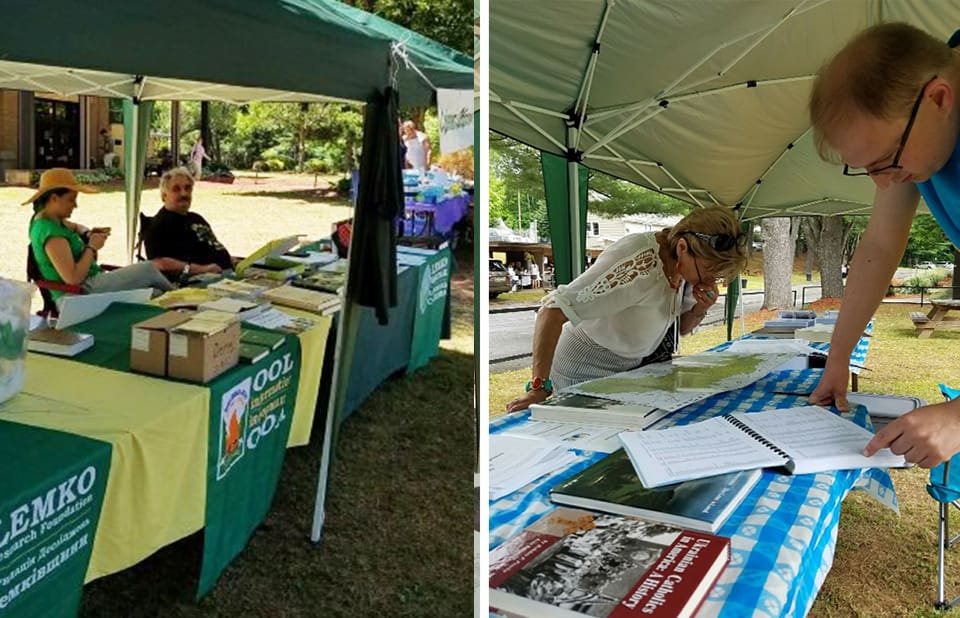
– Why did Vatra become the tradition of Lemko festivals?
– The tradition of lighting a vatra was born not in America, but on Lemkivshchyna. At the end of the 1950’s, when the political thaw began in Poland, many Lemkos, albeit with great difficulty, managed to return from the northern lands to their native Carpathian land (Lemkivshchyna). Often they were forced to buy their homesteads from the Poles, which they took for free, or developed “from scratch”.
And then the Lemkos who returned decided to gather near the vatra (“fire”) to feel the warmth of the gatherings, to talk, remember, sing and play. In Ukraine, too, were conducted for a long time, for example, the Kupala Vatras, but Lemko Vatras became the most widespread and turned into a festivals. People from all over the world began come to such Vatras.
– And can you name the most famous Lemko vatras-festivals?
– Yes. In the village of Zdynia, Malopolska Voivodship, Poland, this year, for the 35th time in July, is holding a three-day annual International Lemko ethnographic festival called “Lemkivska Vatra”. It is in original Lemko lands – the Carpathian Beskydy (ridges), in the south-eastern part of Poland. Beskydy is famous for Lemkos, as the Catskill Mountains in the north of New York for the American Ukrainians.
People and creative teams of Lemkas from Ukraine, Poland, Slovakia, Croatia, Canada and other countries come to Zdynia. The goal is to keep the tradition and native culture with the song, word, and dance. And friendship, unity.
Author Annex-1. While writing the article, I read the announcement of this XXVV’s oldest vatra, and here are the promises of the organizers: “But we shouldn’t forget, that the most important for the vatra – is time together, the knowledge of new people from all over the world, and celebration with diverse music. It will not be as many as a handful, but as the whole barrels and cart! “
So, music and singing would be measured by “carts” and barrels. “
– And in Ukraine too?
– Of course. The most famous is the All-Ukrainian Festival near the city of Monastyrysk, Ternopil region. At a distance of several kilometers from it there is a tract in which the “Lemko village” (open-air museum) was built. It occupies 30 hectares, and here, on open space, the All-Ukrainian Society “Lemkivshchyna” holds a festival called “Bells of Lemkivshchyna” (“Dzvony Lemkivshini”). It is only one year older than ours, that is, this year, in the beginning of August, will be the 18th. He became famous for a large number of participants. In the past year and the year before (as it is written) their vatra attracted up to 30 thousand guests along with the performers. The number of performers is not small: up to 100 Lemko groups, not counting individual singers.
Also there are more local vatras in some cities of Galicia. It seems that there are already more than a dozen of them. We are going to the Congress of our federation in August, and on the 3rd day, August 26, there will be a vatra in the Zimna Voda village, not far from Lviv. It is organized by Lemkos of Lviv and its surroundings. They cannot imagine themselves without a vatra, for communication, singing.
Author Annex-2. It turns out that Lemko festivals have become popular in Ukraine during the last two decades. In 2011, for the first time, the Lemko Festival-Vatra took place on the Left Bank of Ukraine, namely in the Poltava region, in the village Lyutensky Budyshcha, Zinkivsky district, under the name “Barvi Lemkivshchyny” (“Colors of Lemkivshina”). Now the festival has become regional and is held annually. After all, up to 10 thousand resettlements of Lemkos with children and grandchildren live in Poltava region.
The common slogan of all the vatras is “Cne mi sja za tobom, mij Lemkivskij kray” (“I Miss You, My Lemko Land”).
And why all those who were even not born in this land are longing for it, Andriy Khomyk answered in his poem in prose in the style of Mikhail Kotsyubinsky. His anwer to the question “” comes from the bottom of his Lemko heart, which is burning, as Lemko fire – Vatra:
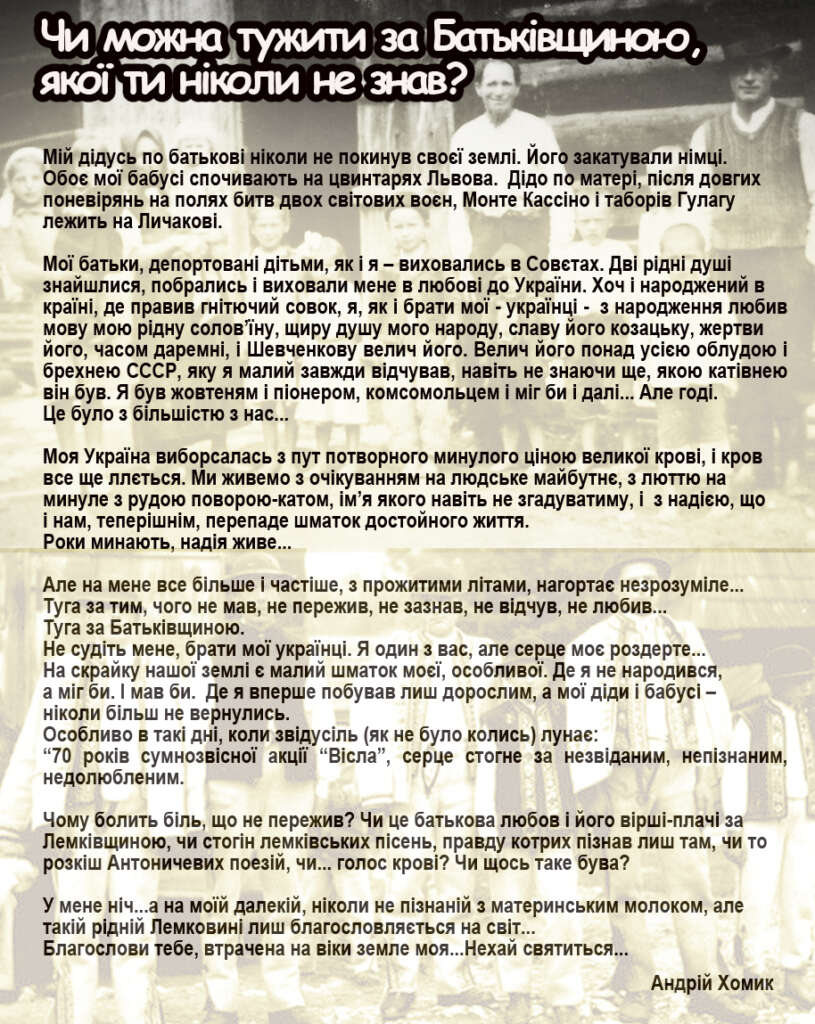
Author Annex-3. And what was most surprising when I were searching the history of Lemkos through the very same Google. What was the reason that they, despite persecution, misery, deportations, prisons, insults, always revive, like the Phoenix of the ashes? I think so: due to genetic hardening in a difficult natural conditions of their settlement (mountains, lack of fertile land). Due to hard work and ability to adapt to life in extreme conditions. Due to tolerance, nonconflict, respectful attitude towards other people. Due to trying to settle together, and not to be scattered. Due to general rule not to create mixed families. And the most importantly – due to the careful preservation of their folk culture, customs, rituals. In the places of resettlement, if there were only a few Lemko families, they organized common evening parties, christenings, weddings, on Easter – basket-weaving, where put Paska and Easter eggs.

It is worthy of praise, how friendly Ukrainian Lemoas united in the All-Ukrainian Society “Lemkivshchyna” (2001), as persistently continue a huge work to restore historical justice. After all, until the 1990s, it was forbidden even to publicly speak of the 1944-1951 deportation of the Lemkos and Operation Vistula of 1947. And in 1991, already two thousand Lemkos managed to go to the International Vatra in Zhdinia. They began to speak in a full voice. And they combine their efforts with foreign settlers and their descendants.
******
“Lemko-Vatra-2017” of American Lemkos in Ellenville, USA, has ended. The guests of the festival have felt in their hearts the fire, which was lit by its hosts. Not only the flame of a real vatra, but also the fire of their hospitality, generosity, friendliness, an example of zealous work. Such volume of volunteer-public work that, since 1933 – it was the year of the Rusyns’ plan (so-called Lemkos then) to unite here in the United States into an organization – and to this days it is possible to do only with fire in heart and soul.

Author – Lydia Korsun, New York.
“Chas i Podiji” (Chicago),
no. 28, 2017,
July 13 , 2017
Pictures by Julie Wyslocki, Andriy Khomyk and open internet sources.

